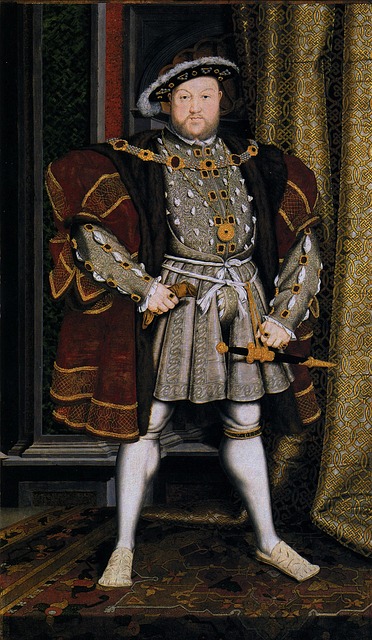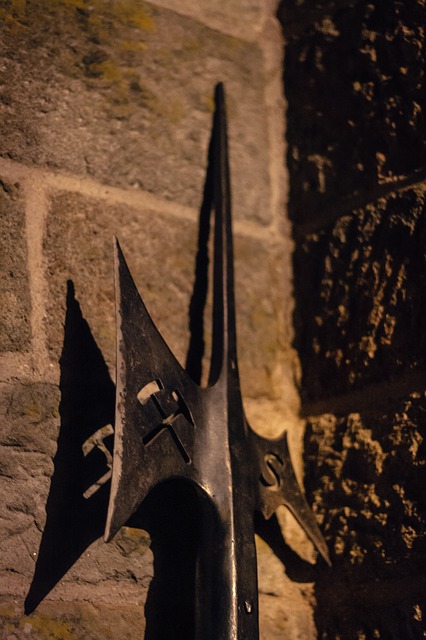By Tim Lambert
The Mary Rose was a great Tudor warship. However, it is a myth that the Mary Rose sank on its maiden voyage! It was launched in 1511 and it did not sink until 1545!
The Mary Rose was a new kind of warship. In the Middle Ages, battles at sea were like battles on land. On both ends of the ship were raised decks called castles from which archers could rain arrows on enemy sailors. Ships would then grapple, and sailors fought hand to hand. In the 15th century, guns were mounted on the top deck.
At the beginning of the 16th century, the design of ships changed. Before then, English ships were usually clinker-built i.e. they were built with overlapping planks. Then ships began to be carvel-built i.e. they were built with planks laid side by side. That allowed shipwrights to cut hatches called ports in the sides of the ship through which guns could be fired.
The Mary Rose was one of the new ships. She was built in Portsmouth between 1509 and 1511 and was almost entirely made of oak, although the keel was made of elm. About 600 trees were cut down to build her! Mary Rose had a total length of 45 metres, 4 masts, and 91 guns. She was refitted in 1536.
It used to be thought that Mary Rose was named after Henry VIII’s sister Mary and the Tudor Rose. However, it has been suggested that she was named after the Virgin Mary.

The Mary Rose normally had a crew of 415, 200 sailors, 185 archers and soldiers and 30 gunners. (On the day she sank, the Mary Rose had extra men on board. One account said there were 700 men, but that is now believed to be an exaggeration. There may have been about 600 men onboard.
Weapons on the Mary Rose
On board the Mary Rose, there were bronze and iron guns. Bronze guns were muzzle (front) loaders, and most iron guns were breech (back) loaders. As well as the large guns on the main deck, the Mary Rose carried swivel guns. They were smaller guns mounted on forks on the gunwale (the top edge of the side of the ship). The ship carried iron, lead, and stone shot and canister shot (wooden tubes filled with pieces of sharp stone). Guns were lit with a linstock (a stick with a string wound around it. The string was soaked in saltpetre, so when it was lit, it burned very slowly).
Muskets on board were matchlocks (when you pulled the trigger, a smouldering string touched gunpowder and fired the gun).
However, the main anti-personnel weapon was the longbow. Mary Rose normally carried 185 archers and soldiers. Each archer could shoot an arrow about 250 metres. An archer could shoot an arrow every 5 or 6 seconds.
The Mary Rose also carried staff weapons like halberds, bills and pikes. A halberd was a long pole with a spear point on its end and an axe below it. A bill was a chopping blade with a hook on the end of a pole. A pike was a staff with a sharp spike on the end.

Remember, if possible, you did not want to sink the enemy ship. If possible, you wanted to board it and capture it.
Navigating the Mary Rose
To navigate, Tudor sailors had a compass and they had books called rutters, which contained details of the shoreline, currents, make-up of the seabed etc. To measure depth, they used a lead weight on a rope with knots tied at intervals. At the bottom of the weight was a recess filled with tallow. It was used to bring up a sample of the seabed.
To measure speed, a log reel was used. A rope with knots tied at intervals was wound around a reel. One end was tied to a wooden board that was thrown into the sea. The rope was gradually unreeled, and using a sand timer, the sailors measured how many knots went out in an hour.
Life on Board the Mary Rose
Sailors onboard the Mary Rose ate well. At that time, the English navy did not sail far. Since they had short voyages, food was usually fresh. Sailors ate beef (although pork bones were also found on board), cod, cheese, butter, peas, and bread. As well as their rations, they could buy their own food and bring it on board. Plum stones were found on the Mary Rose.
So were peppercorns. They must have belonged to an officer, as pepper was very expensive. Although pepper was also used as a medicine and the barber-surgeon may well have had some pepper in his cabin. Sailors were allowed 8 pints of beer a day. (In those days, people were wary of drinking water unless they knew it came from a clean source. Everyone drank beer).
At the bottom of the ship, in the hold, were two big ovens. Cauldrons were made of copper with lead rims. They sat on top of brick boxes, and log fires were lit underneath them. Food could be placed in linen bags and boiled in the cauldron. Also, meat could be hung over the fireplace and roasted.
Officers ate from pewter dishes and bowls. Ordinary sailors used wooden bowls and tankards. Everybody carried a knife, but there were no forks. You used your fingers.
Sailors onboard the Mary Rose were volunteers; they were not press-ganged, and life on board was not at all bad compared to life on land. However, only officers had cabins. Ordinary sailors slept on the deck. (If they were lucky, they might sleep on a mat).
Sailors stood on average between 5 feet 7 inches and 5 feet 8 inches tall. (It is a myth that people were much smaller than we are today). Most sailors had very few possessions, although some had rosaries. Officers had books and inkwells, and a bone manicure set was found.
In their spare time, sailors played games like backgammon and nine men’s morris. Music was popular with all classes in the 16th century. On board the Mary Rose, tabor pipes and a drum were found. So were fiddles and a shawm (the ancestor of the oboe).
The Barber-Surgeon on board the Mary Rose
On board the Mary Rose was a barber-surgeon, with his own cabin. He pulled teeth and performed simple operations such as amputations and setting broken bones.
In Tudor times, medicine was dominated by the theory of the four humours. People believed that the body was made up of four humours or liquids. They were phlegm, blood, yellow bile and black bile. If a person had too much of one humour, they fell ill.
In Tudor times, a common way to diagnose illness was to examine the look, smell, and even taste of the patient’s urine! The barber-surgeon also had many ointments and herbal medicines. He used a syringe to clean wounds with wine or seawater.
Sinking and recovery of the Mary Rose
Mary Rose sank on 19 July 1545. We are not sure why. Although it was in a battle, there is no evidence that French fire sank the Mary Rose. According to one account, the Mary Rose was turning and a sudden gust of wind tipped her over, and water poured in through her gun ports. There may also have been discipline problems on board. Henry VIII was watching from the shore when the Mary Rose sank.
The Mary Rose was very quickly covered in silt, and her exact location was forgotten. However, she was rediscovered in 1971, and excavation began. The Mary Rose was raised from the seabed on 11 October 1982, and she is now open to the public. In my opinion, the Mary Rose Museum is one of the best museums in Britain, and it is well worth a visit.
A Timeline of Events at the time of the Mary Rose
1491
Henry VIII is born
1492
Columbus sails across the Atlantic
1493
The great surgeon Paracelsus is born
1494
On his second voyage, Columbus discovers Jamaica. In Portsmouth Henry VII builds the Square Tower.
1495
Portsmouth Dockyard is founded
1497
John Cabot sails to Newfoundland
1509
Henry VIII becomes king of England
Henry VIII marries Catherine of Aragon, his brother’s widow
Work begins on building the Mary Rose
1511
The Mary Rose is launched
1513
The English win the battle of Flodden against the Scots (who were allies of the French)
The Spanish land in Florida
1514
The ship Henry Grace a Dieu is launched
1515
Anne of Cleves is born
1517
Martin Luther begins the Protestant Reformation
1519
Ferdinand Magellan sets sail on a voyage to circumnavigate the world. He is killed on the journey but some of his men make it.
1521
Cortes conquers the Aztecs in Mexico
1522
England is at war with France again
A great iron chain is placed across the mouth of Portsmouth Harbour. It can be lowered to let friendly ships in.
1525
Turkeys are first eaten in England
1526
The war between England and France ends
1527
Henry VIII extends Portsmouth Dockyard
1528
The Spanish reach Texas
1530
Cardinal Wolsey dies
The population of England is about 3 million
1533
Henry divorces Catherine of Aragon. He marries Anne Boleyn.
Pizarro conquers the Incas
1534
Henry VIII makes himself head of the Church of England
Jacques Cartier discovers the St Lawrence River in Canada
1535
Thomas More is executed
In Peru, the city of Lima is founded
1536
The Pilgrimage of Grace (An uprising in the North of England)
Anne Boleyn is beheaded
Henry marries Jane Seymour
An Act of Union unites Wales with England
Catherine of Aragon dies
1536-1540
Henry VIII closes the monasteries and confiscates their property, including the Domus Dei in Portsmouth (now the Garrison Church)
1537
Jane Seymour dies
1540
Henry marries Anne of Cleves but quickly divorces her
Henry marries Katherine Howard
1541
The Irish parliament agrees to recognise Henry VIII as King of Ireland rather than Lord of Ireland
The Spanish discover the Mississippi River
1542
The battle of Solway Moss. The English defeat the Scots.
Kathryn Howard is beheaded
The Spanish reach California
1543
Henry marries Catherine Parr
Copernicus publishes his theory that the Earth orbits the Sun
Portuguese sailors reach Japan
1544
Southsea Castle is built
The English capture Boulogne. They hold it until 1550.
1545
The Mary Rose sinks
1547
Henry VIII dies. His son becomes King Edward VI.